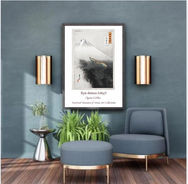


Limited Edition Gallery
Discover a curated selection of exclusive fine art prints, available only in strictly limited numbers. Each piece in this collection has been carefully chosen for its timeless beauty, cultural significance, and refined artistry.
With just 100 prints available across all sizes, these works offer a rare opportunity to own a collectible piece of art history. Once sold out, they will never be reproduced in the same edition again.
Perfect for collectors and design enthusiasts, our Limited Edition Collection brings together delicate Japanese masterpieces and other rare works that deserve a place in truly special interiors.
Styled in real homes

Frost from Momoyogusa – Flowers of a Hundred Generations (1909)
Flowers of a Hundred Generations (Momoyogusa) (1909–1910) by Kamisaka Sekka is one of the great achievements of Japanese design in the early 20th century. Sekka, often called the last master of the Rimpa school, created this series of woodblock-printed designs to demonstrate how traditional Japanese aesthetics could blend seamlessly with modern sensibilities.
Using the mokuhanga woodblock printing technique, Sekka layered delicate washes of color with bold, simplified forms to capture nature in a way that felt both timeless and contemporary. His approach emphasized balance, elegance, and restraint — qualities that made his work resonate with both Japanese and Western audiences.
Sekka’s intent with Momoyogusa was not only to celebrate seasonal beauty but also to create a design manual that would inspire future generations of artists and craftspeople. Each print in the series reflects his belief that art should be both refined and accessible, deeply rooted in tradition yet open to new interpretation.
This reproduction captures the serene atmosphere and technical brilliance of Sekka’s vision — a rare harmony of cultural heritage and modern design.

Ryū Shōten – Ogata Gekkō Japanese Dragon Print (1897)
Ryū Shōten (Dragon Rising to the Heavens) (1897) by Ogata Gekkō is a powerful example of late Meiji‑era Japanese woodblock printing. Gekkō, a largely self‑taught artist, blended traditional ukiyo‑e techniques with elements of modern realism to create works that felt both dynamic and innovative.
In this striking print, Gekkō depicts a dragon ascending through swirling clouds, symbolizing strength, transformation, and divine power. The detailed linework and careful gradations of ink demonstrate his mastery of mokuhanga woodblock printing, while the composition reflects his ability to merge myth with motion.
Gekkō’s intent was to honor Japanese folklore while also appealing to a new audience, as Japan opened itself more to Western influences during the Meiji period. His dragon is not static but alive, embodying movement, energy, and the enduring spirit of Japanese mythology.
This reproduction preserves the drama and artistry of Gekkō’s vision — a timeless piece that bridges traditional legend with modern artistic expression.

Egrets and Reeds in Moonlight – Ohara Koson Print (c. 1930)
Egrets and Reeds in Moonlight (c. 1930) by Ohara Koson is a masterpiece of Japanese shin-hanga (new prints) — a movement that revitalized traditional woodblock printing in the early 20th century.
Koson was celebrated for his sensitive depictions of birds and nature, blending mokuhanga woodblock printing techniques with subtle use of color and light. In this work, graceful egrets stand quietly among tall reeds beneath the glow of the moon, their forms delicately outlined against a misty, atmospheric background.
The artist’s intent was to capture not just the physical likeness of his subjects but also the quiet poetry of the natural world. By emphasizing stillness, balance, and mood, Koson created images that felt contemplative, almost meditative, inviting viewers to pause and reflect.
This reproduction preserves the serenity and elegance of Koson’s vision — a timeless piece of Japanese artistry that evokes peace and refined beauty.















